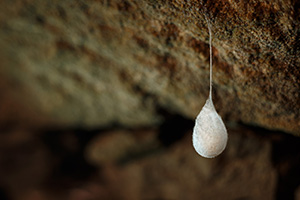Where Do Spiders Lay Eggs?
Portland OR - Beaverton OR - Lake Oswego OR - Vancouver WA

Spiders have unique nesting habits, whether they’re in our homes or out in nature – and that includes where they lay eggs. Understanding where they choose to nest or reproduce helps us better manage and prevent infestations. Here’s what homeowners need to know about where spiders lay eggs, what they look like, and how to get rid of spider eggs easily.
Places Where Spiders Lay Eggs
Whether indoors or outdoors, spiders have a few main places where they often lay eggs. They typically look for areas that are secluded and out of the way, providing their offspring with plenty of protection as they develop and hatch. Some of the most common areas where spiders lay eggs include:
- Dark Corners: Spiders often choose dark and undisturbed corners of your home, such as closets, basements, and attics, to build their nests and lay their eggs.
- Behind Furniture: Hidden from view, spiders may nest behind furniture or within household clutter, utilizing these secluded areas to protect their egg sacs from predators and disturbances.
- Household Fixtures: From light fixtures to electrical outlets, spiders may take advantage of the shelter provided by household fixtures to lay their eggs in out-of-the-way locations.
- Gardens and Shrubbery: Outdoor spiders often lay their eggs among foliage, using plants as a natural shelter to protect their offspring from the elements.
- Rock and Log Piles: Spiders may hide their egg sacs in crevices within rock or log piles, taking advantage of the shelter provided by these natural structures.
- Underneath Structures: From decks and porches to sheds and outdoor furniture, spiders may seek out sheltered spots underneath outdoor structures to lay their eggs away from prying eyes.
Ready for pest service?
We'll call you! Leave your information below.
Do Spiders Lay Eggs Indoors?
Yes, spiders do lay eggs indoors, taking advantage of the sheltered environment and abundant prey that your home provides. Since arachnids are opportunistic creatures, they won’t hesitate to move into your property if it offers suitable conditions for nesting and reproduction.
Identifying indoor spider egg sacs can be a bit of a challenge, as they are often hidden from view in inaccessible areas. However, if you notice an increase in spider activity or webs in certain areas of your home, it may be a sign that spiders have established nesting sites indoors. Keep an eye out for egg sacs attached to surfaces using strands of silk, particularly in corners, crevices, and other hidden locations.
What Do Spider Eggs Look Like?
Ever stumbled across a tightly-knit ball of web in your home or garden? Chances are, you may have unwittingly encountered a spider egg sac. While the egg sac of each spider species may vary a little, spider eggs generally share these main characteristics:
- Size and Shape: Spider egg sacs vary in size and shape, ranging from small and spherical to larger and elongated. Most look like some type of miniature cotton ball wrapped in silk.
- Color: Egg sacs can be translucent or opaque, with colors ranging from white to brown, depending on the species.
- Texture: The texture of spider egg sacs generally ranges from smooth to slightly bumpy, depending on the materials used in their construction. Regardless, most are nestled web.
- Attachment: Spider egg sacs are typically attached to surfaces using strands of silk, often found in corners, crevices, or hidden areas.
Signs of Spider Eggs in Your Home
Not all homeowners may stumble upon visible egg sacs, but there are subtle signs that spiders may be reproducing within your property. Here are indicators to watch for if you suspect spiders are laying eggs in your house:
- Increased Spider Activity: If you notice a sudden surge in spider sightings around your home, it could be a sign that spiders are actively reproducing. Keep an eye out for spiders scurrying across walls, ceilings, or floors, especially in areas where they were not previously seen.
- Presence of Spider Webs: While you may not always spot egg sacs, the presence of spider webs can be a telltale sign of spider reproduction. Pay attention to the frequency and location of webs around your home, as spiders often construct webs to capture prey and provide shelter for their offspring.
- Spiderlings: The emergence of tiny spiderlings can indicate successful egg hatching within your home. Keep an eye out for clusters of small spiders, particularly in areas where adult spiders are frequently seen or where webs are present.
- Unexplained Bites or Allergic Reactions: In rare cases, unexplained bites or allergic reactions may indicate the presence of spider eggs or spiderlings in your home. If you or your family members experience unusual bites or allergic symptoms without encountering visible spiders, it may be worth investigating for hidden nests or egg sacs.
What to Do If You Find Spider Eggs
Discovering spider eggs in your home can be a cause for concern, but the solution is relatively simple; just vacuum up the sac and promptly throw away the vacuum bag in an outdoor receptacle. Just be cautious not to rupture the sac, as this may release spiderlings into your home.
If you come across spider eggs, you may also want to invest in professional pest control. While spiders can be beneficial in small numbers, egg sacs could be a sign of a bigger infestation. Working with experts is the best way to determine the extent of the infestation and come up with an effective, long-term treatment plan.
Don’t let unwanted spider guests take over your home. Contact Summit Pest Management today for expert spider removal services. Our team of trained professionals will assess your situation, implement effective treatments, and restore peace of mind in your home.
Back to Spider Exterminators – Control – RemovalWhere Do Spiders Lay Eggs? in Portland OR & Vancouver WA
Serving Portland Oregon & Vancouver Washington
